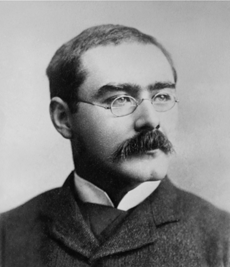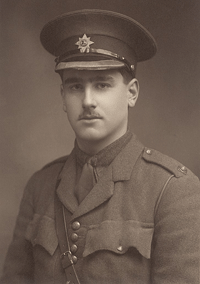|
Rudyard Kipling
Answer
to Name
This Famous Person Game - December 2015
by Mike McLeod
|
 |
Where do you think Rudyard Kipling wrote The Jungle Book, Captain’s Courageous and Gunga Din? Not in India or England where he spent his much of his life. Kipling’s world-famous collection of short stories in The Jungle Book and the poem Gunga Din (that idolized a lowly water carrier for British soldiers) were written in the United States in Vermont. But that’s getting ahead of the story.
Joseph Rudyard Kipling was born on Dec. 30, 1865 in Bombay, India. His father Lockwood taught at the Sir Jamsetjee Jeejebhoy School of Art to provide for his wife Alice and their daughter and son. Young Rudyard loved India, but at the age of six, he was sent to England—against his wishes—for a proper education. To make matters worse, the family who boarded him there were unkind—to put it mildly—and he also did poorly in school. It was not until word of his predicament reached his mother that young Kipling was rescued by her and placed in a better school where he flourished.
With no funds to pursue college, Kipling happily returned to India. His first job was at a newspaper, and thus began his literary career. In 1892, he married Carrie Balestier, an American he had met in London. They took up residence in her hometown of Brattleboro, Vermont, where Kipling wrote several famous works.
Over his lifetime, Kipling wrote thousands of short stories and poems and a few books. Looking at the long list of his works, it is apparent that Kipling’s mind was filled with stories. In 1907, he won the Nobel Prize for Literature, the first from Britain to do so and the youngest overall at the age of 421. Along with the medal, the financial reward totaled almost $800,000 in today’s coinage.
About a decade before this financial windfall, Kipling was judged to be the highest paid writer in the world.2 It is said that he was paid ten shillings per word (about $2.70 then or $65-$78 today) at the high points in his career. A story is told of a few Oxford students who, upon hearing this, sent ten shillings to Kipling and asked for “…one of his best words. He cabled back, ‘Thanks.’”3
|

Rudyard Kipling in 1865.

17-year-old John Kipling
|
Kipling loved telling bedtime stories to his children Josephine, Elsie and John. Many he published, including the well-known, “Rikki-Tikki-Tavi,” “Wee Willie Winkie” and the Just So Stories for Little Children. Within The Phantom Rickshaw and other Eerie Tales was the classic adult novella, The Man Who Would Be King, which was made into a movie of the same name starring Sean Connery, Michael Caine, and Christopher Plummer as Rudyard Kipling. (I highly recommend this movie as a must-see.) Of course, The Jungle Book was immortalized on film by Disney and others—and it will be doubly immortalized again in 2016 and 2017 with the premiers of two new remakes: The Jungle Book and The Jungle Book: Origins. Both have all-star casts voicing the CGI animals—in 2016: Scarlett Johansson (Kaa); Bill Murray (Baloo); Christopher Walken (King Louie); and Ben Kingsley (Bagheera); and in the 2017 version: Christian Bale (Bagheera); Benedict Cumberbatch (Shere Khan); Cate Blanchett (Kaa). Interesting choices in casting women as the snake Kaa in both movies.
While Kipling’s talent made good fortune rain down upon him and his family, tragedy also often struck. His daughter Josephine at about the age of 6 died from pneumonia that she contracted while sailing to America with her family. Kipling also developed pneumonia on the same voyage, but he survived. A headline in the March 7, 1899 New York Times read:
“JOSEPHINE KIPLING DEAD; The Eldest Child of the Author Succumbs to Pneumonia. MR. KIPLING IS DOING FINELY. He Has Not Been Told of His Loss, as the Physicians Fear the Shock Might Cause a Relapse.”
So all the NYT’s readers learned about Josephine’s passing before her father? It appears so.
The loss of their dear daughter Josephine struck Rudyard and Carrie hard. However, the loss of their son John was an even greater blow. In 1915 at the age of 18, John was killed in World War I in a battle for Loos, France. The British had 59,000 casualties in that battle over a 20-day period while the Germans lost half that amount. This one battle accounted for about 20 percent of all Allied casualties in 1915, and to make it worse, no ground was gained due to a German counter attack.4
The reason why John’s death hit Kipling so hard was because he pulled strings to get his son inducted into the military. John had terrible eyesight, and he was rejected several times when he tried to volunteer, even with his father’s influence. Kipling finally was able to get John into the Irish Guards through a high-ranking friend.
John was sent into the battle for Aloos on the second day of fighting. His body was never recovered during Kipling’s lifetime. It was believed to be found later under a marker stating “Unknown Lieutenant of the Irish Guards.”5 Perhaps to assuage his guilt, Kipling took a prominent role with the Imperial War Graves Commission which made gardens out of all British soldiers’ cemeteries around the world.
The Kipling’s other daughter Elsie did survive to adult life, but she never married.
Kipling wrote for the rest of his life. Rudyard Kipling died on January 18, 1936 after an operation on a perforated ulcer.
As also happened with Samuel Clemens, Kipling’s death was mistakenly reported before it actually happened. He wrote to the magazine saying, "I've just read that I am dead. Don't forget to delete me from your list of subscribers.”6
Rudyard Kipling’s ashes are buried in Westminster Abbey near Charles Dickens.
In November of 2015, Skinners auctioned a first edition of Captains Courageous with dust jacket for $3,567 and first editions of the First and Second Jungle Books for $2,337.
Sherry Blanton and Ted Carlton of Utah correctly identified Rudyard Kipling.
---------------------------
1 The Telegraph, “Nobel Prize for Literature: the good, the bad and the British,” by Marie-Claire Chappet, Oct. 9, 2014, Telegraph.co.uk.
2 Daily Mail, “Home where author Rudyard Kipling wrote Kim goes on sale at £1million” by Harriet Arkell.
3 The Kipling Society, The Kipling Journal, December 1966.
4 Edmonds, J. E., Military Operations France and Belgium, 1915: Battles of Aubers Ridge, Festubert, and Loos, published 1928.
5 War Memorials Archive Blog, “The controversy over John Kipling’s burial place,” by ukniwm, Dec. 11, 2007.
6 Bernhard, Jim, Final Chapters: How Famous Authors Died, Skyhorse Publishing, 2005.
Learn
about more Famous People
|